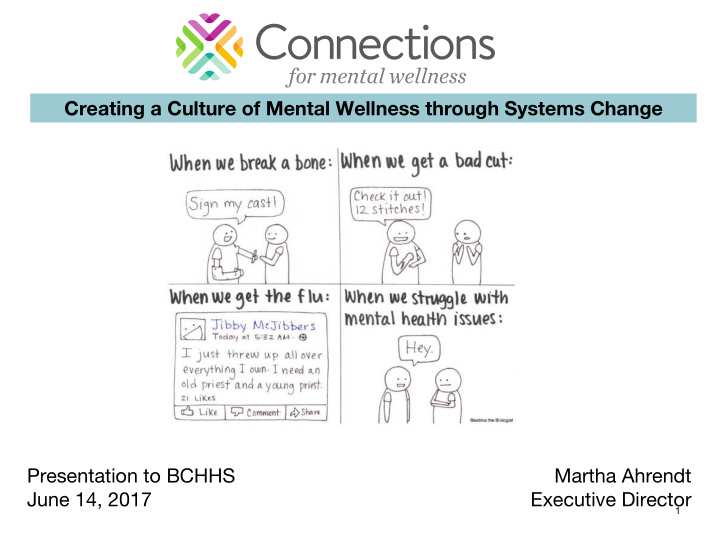



Creating a Culture of Mental Wellness through Systems Change Presentation to BCHHS Martha Ahrendt June 14, 2017 Executive Director 1
Our Mission To transform the mental health of our community through collaboration, education and enhanced systems of care 2
Our Vision Children Adults Families We envision a community that values and embraces the need for mentally healthy children, adults, and families. 3
Steering Committee Co-Chairs: • Sharla Baenen, Bellin Health/Psychiatric Center • Paula Manley, Prevea/HSHS Members: • Ryan Good, American Foundation of Counseling Services • Aurora BayCare • Ian Agar, Brown County Human Services, Behavioral Health • Erik Hoyer, Brown County Supervisor • Celia Gardner, Catholic Charities • Sarah Inman, Brown County United Way • Lois Mischler, Family Services of Northeast Wisconsin • Jerry Wieland, Howard-Suamico Schools • Larry Connors, Jackie Nitschke Center • Cheryl Weber, JOSHUA • Dr. Robert Gouthro, Medical College of Wisconsin, Psychiatry Residency Program/Veteran’s Clinic • Bob Johnson, Samaritan Institute 4
Steering Committee Workgroups Governance Community Strategy Members Vision Connections Action Public Will Planning Implementation Partnering Organizations 5
6
Adult Mental Health & Wellness Population-level Change through Results-based Accountability 7
Poor Mental Health Days (PMHD) 33% of adults have 1+ PMHD/month (n=64,000) 8
9
10
Designated Mental Health Professional Shortage Area --U.S. --Wisconsin --Brown County --MCW --Connections Mental Health Provider = psychiatrist, clinical psychologist, clinical social worker, psychiatric nurse specialists, marriage and family therapists U.S. Department of Health and Human Services, 2015 11
Adult Outcomes/Outputs Factors Strategies Population Knowledge and Know- Worksite Clinics and Wellness Programs How Provide Mental Health Screeners Strategy 1: Improve Employee Roles w/Mental Health Workplaces Literacy Social Employed Support Adopt Mental-Health Friendly Policies and Practices Faith Organizations Increase Access Mental Health Literacy Strategy 2: Community Unem- Non-Mental-Health Agencies Improve ployed & Mental Health Literacy Unable to Detection Work & Develop Interagency Communication Treatment Increase On-line Access & Information Strategy 3: Workforce Awareness Expand Trainee Opportunities 12
School Based Mental Health Initiative 13
Children’s Mental Health 1 in 5 children ages 13-18 have, or will have, a serious mental health • disorder. 50% of lifetime cases of mental illness begin by age 14. • Wisconsin youth have the 2 nd highest prevalence of sever major • depressive episodes in the country. Between 60-90% of children with mental health disorders do not • receive treatment. 14
School-Based Services One-on-one counseling provided at a school location • Identified for kids who have barriers to care at a traditional setting • Promising interactions and integration between counseling/classroom • School districts and mental health providers • Creating common set of protocols, guidelines, and system within • schools and with providers. 15
16
Workgroups Children Adults Families Non-MH Professionals and Mental School Health/Wellness Based Mental Health Community Faith Employers/ Services Service Leaders Workplace Providers Access Mental Health Expand Trainee Interagency Information Portal Opportunities Relationships aligning with 2-1-1 17
Thank You! Please contact any of our collaborators or Martha Ahrendt, Ph.D. Connections for Mental Wellness director@connectionsMW.org 920-606-9192 18
Recommend
More recommend